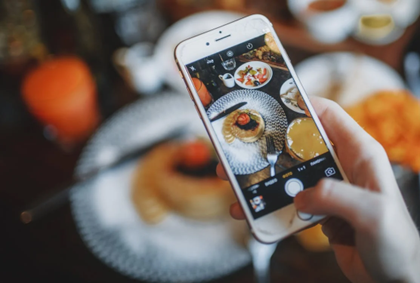Written by: Rafael Guimarães & Kristen DiFilippo, PhD, RDN
Mobile technologies are growing exponentially worldwide, reaching 7.95 billion accounts in 2020, 6.06 billion of which are on smartphones (Jejdling et al., 2021). In the United States between May 2011 and January 2014, the number of smartphones among adults increased from 35% to 58% (“Mobile fact sheet,” 2021), and jumped to 85% in 2021(Kolmar, n.d.).
Social media is widely used to consume health information, regardless of gender or age (Xiong & Liu, 2014). Users share health information, such as eating habits and medical information for disease prevention. This can help with health literacy and adherence to treatments. Despite this, care should be taken with the source of the information, as false or misleading information easily spreads across social media (Levy & Strombeck, 2002; Vosoughi, Roy, & Aral, 2018). An area of particular concern is the impact social media can have on encouraging disordered eating behaviors.
Let’s take a look at how social media can influence healthy eating and eating disorders and what strategies can be taken to promote healthier behaviors.
Eating disorders
Eating disorders are serious and often fatal illnesses that are associated with severe disturbances in people’s eating behaviors and related thoughts and emotions.” Eating disorders can present in different ways, such as bulimia nervosa, binge eating, and anorexia nervosa. (National Institute of Mental Health, 2023).
Anorexia nervosa is a condition where the person severely restricts the amount of food intake. A binge eating disorder is a condition where a person has recurrent episodes of consuming large amounts of food with a feeling of a loss of control. Bulimia nervosa, in turn, is a condition in which people have episodes of eating a large amount of food followed by behaviors that compensate for this high intake, such as forced vomiting, use of laxatives, fasting, or strenuous exercise (National Institute of Mental Health, 2023).
These behaviors can bring several health risks, such as anemia, severe constipation, multiple organ failure, infertility, and severe dehydration.
Social Media
Social media can be supportive of positive eating behaviors. For instance, showing visual images about food and fitness can influence people to change nutrition and exercise behaviors (Quick et al., 2015). The use of social media to encourage the consumption of fruits and vegetables can be positive and can positively influence the behavior of others (Holmberg, E. Chaplin, Hillman, & Berg, 2016). However, there is an association between the frequency of comparing physical appearance to those on social media and body dissatisfaction and drive for thinness (Jiostsa et al., 2021). The promotion of a thin ideal is pervasive on social media (Aparicio-Martinez et al, 2019). This often leads to unhealthy methods to change the body. Health professionals should be aware of the impact social media use can have on body image and disordered eating behaviors.
When using social media to promote health, we should always consider the potential for unintended negative consequences. We can also support positive messaging to bring awareness that can be harnessed in social media. Peer influence through social media can be an effective channel to involve the population, as some health topics can be taboo in society and are difficult to disseminate. Despite this, false or misleading information can be quickly disseminated and negatively influence the population’s eating habits (Chung et al., 2021).
Social media can be an effective tool to encourage healthier eating; however, care must be taken to reduce the potential risks of harm.
References
Chung, A., Vieira, D., Donley, T., Tan, N., Jean-Louis, G., Kiely Gouley, K., & Seixas, A. (2021). Adolescent peer influence on eating behaviors via social media: Scoping review. Journal of Medical Internet Research, 23(6), e19697. doi:10.2196/19697
Holmberg, C., E. Chaplin, J., Hillman, T., & Berg, C. (2016). Adolescents’ presentation of food in social media: An explorative study. Appetite, 99, 121–129. doi:10.1016/j.appet.2016.01.009
Jejdling, F., Lundvall, A., Jonsson, P., Carson, S., Möller, R., Davis, S., … Kuoppamaki, K. (2021). Retrieved December 8, 2022, from https://www.ericsson.com/4a03c2/assets/local/mobility-report/documents/2021/june-2021-ericsson-mobility-report.pdf
Kolmar, C. (n.d.). U.S. smartphone industry statistics [2023]: Facts, growth, trends, and forecasts. Retrieved February 2, 2023, from https://www.zippia.com/advice/us-smartphone-industry-statistics/
Levy, J. A., & Strombeck, R. (2002). Health benefits and risks of the Internet. Journal of Medical Systems, 26(6), 495–510. doi:10.1023/a:1020288508362
Mobile fact sheet. (2021, April 7). Retrieved December 8, 2022, from Pew Research Center: Internet, Science & Tech website: https://www.pewresearch.org/internet/fact-sheet/mobile/
National Institute of Mental Health. (2023). Eating disorders. Retrieved September 3, 2023, from National Institute of Mental Health (NIMH) website: https://www.nimh.nih.gov/health/statistics/eating-disorders
Quick, V., Corda, K. W., Martin-Biggers, J., Chamberlin, B., Schaffner, D. W., & Byrd-Bredbenner, C. (2015). Short food safety videos promote peer networking and behavior change. British Food Journal (Croydon, England), 117(1), 78–93. doi:10.1108/bfj-09-2013-0270
Vosoughi, S., Roy, D., & Aral, S. (2018). (Xiong & Liu, 2014), Science (New York, N.Y.), 359(6380), 1146–1151. doi:10.1126/science.aap9559
Xiong, F., & Liu, Y. (2014). Opinion formation on social media: an empirical approach. Chaos (Woodbury, N.Y.), 24(1), 013130. doi:10.1063/1.4866011
Jiotsa B., Naccache B., Duval M., Rocher B, & Grall-Bronnec, M. Social Media Use and Body Image Disorders: Association between Frequency of Comparing One’s Own Physical Appearance to That of People Being Followed on Social Media and Body Dissatisfaction and Drive for Thinness. Int J Environ Res Public Health. 2021 Mar 11;18(6):2880. doi: 10.3390/ijerph18062880. PMID: 33799804; PMCID: PMC8001450.
Aparicio-Martinez, P., Perea-Moreno, A.J., Martinez-Jimenez, M.P., Redel-Macías, M.D., Pagliari, C., & Vaquero-Abellan, M. Social Media, Thin-Ideal, Body Dissatisfaction and Disordered Eating Attitudes: An Exploratory Analysis. Int J Environ Res Public Health. 2019 Oct 29;16(21):4177. doi: 10.3390/ijerph16214177. PMID: 31671857; PMCID: PMC6861923.
Blog image source: Roman Odintsov via Pexels















